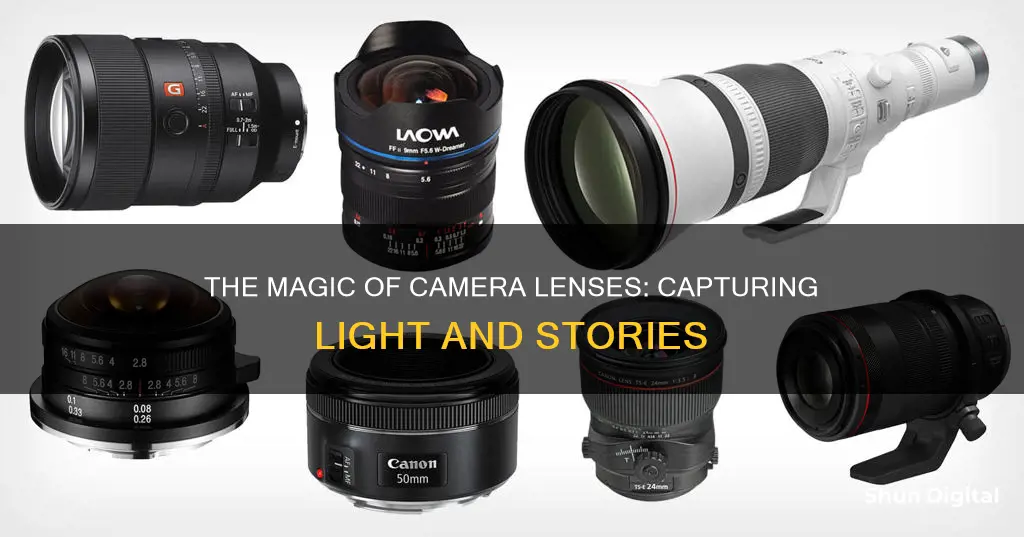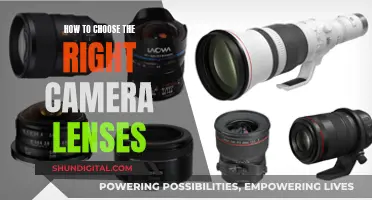
The function of a camera lens is to gather and focus light reflected from a scene or subject. The lens then directs the light onto the camera's image sensor or film, which captures the colours and intensity of the light rays. This process allows the camera to reproduce the image seen through the viewfinder or LCD screen.
The basic components of a camera lens include the front element, lens groups, aperture, and rear element. The front element is critical to the performance of the lens assembly, as it is the foremost piece of glass that faces the subject. The lens aperture determines how much light is allowed to reach the image sensor, and can be adjusted to be larger or smaller. The lens's focal length determines the magnification of the image, and different focal lengths offer different fields of view.
What You'll Learn
- Camera lenses focus light onto the camera's image sensor or film
- They control factors like framing, perspective, depth of field, and the light entering the camera
- The lens aperture determines how much light reaches the image sensor
- The focal length of a lens determines the magnification of the image
- Camera lenses can be zoom or prime

Camera lenses focus light onto the camera's image sensor or film
The function of a camera lens is to focus light onto the camera's image sensor or film. This is achieved through a series of curved pieces of glass or plastic, known as 'elements', which are held together by a 'barrel'. The lens collects and focuses light reflected from a scene or subject, directing it to the image sensor, which captures the colours and intensity of the light rays. This captured light is then reproduced as an image.
The lens aperture determines how much light is allowed to reach the image sensor. The aperture opening can be adjusted to be larger or smaller, with different settings known as 'F Stops'. Aperture settings also affect the depth of field in an image, which refers to how much of the area around a subject will be in or out of focus.
The focal length of a lens is the distance from the optical centre of the lens to the image sensor when the camera is focused on infinity. Different focal lengths offer different fields of view, with shorter focal lengths providing a wider field of view, and longer focal lengths resulting in a narrower field of view and greater magnification.
Lenses with a single focal length are known as 'prime lenses', while those with variable focal lengths are called 'zoom lenses'. Zoom lenses allow photographers to capture different views of a scene without changing their position or lens. However, prime lenses tend to offer sharper images as light passes through fewer elements, resulting in less distortion.
The quality of a lens is extremely important in photography. A high-quality lens can help capture great photos, even with a cheap camera body. Conversely, a low-quality lens can hinder the performance of even the best camera, resulting in poor image quality.
Calibrating Camera Lenses: The Ultimate Guide to Perfection
You may want to see also

They control factors like framing, perspective, depth of field, and the light entering the camera
Camera lenses play a crucial role in photography, as they significantly influence the final image produced. They control various factors, including framing, perspective, depth of field, and the amount of light entering the camera.
Framing
The ability to frame an image is a fundamental aspect of photography, and camera lenses play a vital role in this process. By choosing different lenses, photographers can capture various scenes and subjects within the frame. For example, a wide-angle lens allows photographers to include more of the scene in the frame, while a telephoto lens brings distant objects closer, excluding the surrounding environment.
Perspective
Camera lenses also control the perspective of an image, which refers to how objects appear in relation to each other and the viewer's position. Using different lenses can change the emphasis on certain elements within the frame. For instance, a wide-angle lens can exaggerate the size of objects in the foreground relative to those in the background. In contrast, a telephoto lens reduces this emphasis, making objects appear more compressed.
Depth of Field
Depth of field refers to the range of distances within a photo that appears acceptably sharp. Camera lenses influence the depth of field by controlling the aperture, which is the opening within the lens that allows light to pass through. A wider aperture results in a shallower depth of field, while a narrower aperture provides a greater depth of field.
Light Control
One of the primary functions of a camera lens is to gather and focus light onto the camera's image sensor or film. Lenses are composed of curved pieces of glass or plastic that direct light rays toward the image sensor. By adjusting the lens aperture, photographers can control the amount of light entering the camera, thereby affecting the exposure and brightness of the final image.
In summary, camera lenses are essential tools for photographers, as they provide control over framing, perspective, depth of field, and light, ultimately determining the visual outcome of an image.
The Magic of Camera Filters: Enhancing Your Lens's Vision
You may want to see also

The lens aperture determines how much light reaches the image sensor
The camera lens is often referred to as the "eye" of the camera and is arguably the most important part of the camera. The lens aperture is an integral part of the camera lens and plays a crucial role in photography.
The lens aperture is an adjustable opening within the camera lens that controls the amount of light that reaches the image sensor. This mechanism is composed of multiple blades that can expand or contract to alter the size of the opening. By doing so, the aperture setting, also known as the f-stop, directly influences the depth of field and the image's exposure. A larger aperture, denoted by a smaller f-number, allows more light to reach the image sensor, resulting in a shallower depth of field. Conversely, a smaller aperture, represented by a larger f-number, reduces the amount of light reaching the sensor and yields a greater depth of field.
The aperture setting is a critical tool for photographers to manipulate various aspects of their photographs. It empowers them to influence artistic choices such as sharpness, distortion, and framing. Additionally, the aperture setting has a direct impact on the exposure of an image. By adjusting the aperture, photographers can control the amount of light that reaches the image sensor, thereby affecting the brightness or darkness of the final image. This feature is particularly useful when shooting in low-light conditions or when aiming to capture specific lighting effects.
The lens aperture also plays a role in determining the shutter speed required for a given exposure. A wider aperture, with a smaller f-number, enables the use of a faster shutter speed, which is advantageous when photographing fast-moving subjects or in situations where motion blur needs to be minimised. Conversely, a narrower aperture, with a larger f-number, necessitates a slower shutter speed, which can be beneficial for creating motion blur effects or capturing long exposures.
It is worth noting that the lens aperture is just one aspect of a camera lens's functionality. Camera lenses also include other components such as the front element, lens groups, and the rear element, each serving a specific purpose to focus and direct light onto the image sensor. Additionally, different types of lenses, such as prime lenses and zoom lenses, offer unique capabilities and are suited for different photographic situations. Nonetheless, the lens aperture remains a key factor in determining how much light reaches the image sensor, ultimately influencing the overall exposure and visual characteristics of the final image.
Camera Lenses in China: Cheaper or Expensive?
You may want to see also

The focal length of a lens determines the magnification of the image
The function of a camera lens is to focus light from the viewfinder onto a tiny spot on the camera's image sensor or film. This process allows the camera to capture images by controlling aspects like framing, perspective, depth of field, and the amount of light entering the camera. The lens aperture, or opening, can be adjusted to let in more or less light, and this setting also affects the depth of field in an image.
The focal length of a lens is the optical distance from the point where light meets inside the lens to the camera's sensor, usually measured in millimetres. It is not a measurement of the physical length of the lens. The longer the focal length, the narrower the angle of view and the higher the magnification. Conversely, a shorter focal length results in a wider angle of view and lower magnification.
Lenses with different focal lengths produce different fields of view. A lens with a focal length of 45mm will have a much wider field of view than a lens with a focal length of 245mm. The latter will also produce greater magnification of the subject. Camera lenses are typically categorised as wide-angle, telephoto, or standard lenses based on their focal lengths. Wide-angle lenses have focal lengths below 45mm, telephoto lenses have focal lengths above 85mm, and standard lenses have mid-range focal lengths between 50mm and 85mm.
The focal length of a lens also determines how "zoomed in" or "zoomed out" an image appears. Higher values, such as 500mm, are more "zoomed in", while lower values, like 20mm, are more "zoomed out". This is why longer focal lengths are commonly used in wildlife photography and sports photography, as they bring distant subjects closer.
Dual-Lens Camera Tech: How Does It Work?
You may want to see also

Camera lenses can be zoom or prime
The function of a camera lens is to gather and focus light reflected from a scene or subject. The light rays enter the camera lens and pass through the lens elements, which direct them to the camera's image sensor. The image sensor then captures the colours and intensity of the light rays, which are reproduced as an image.
There are two main types of camera lenses: prime lenses and zoom lenses.
Prime Lenses
Prime lenses have a single, fixed focal length, such as 35mm, 50mm, or 85mm. This means that the angle of view cannot be changed without physically moving closer to or further away from the subject. Prime lenses are known for their sharpness, wide apertures, and higher image quality. They are also generally smaller, lighter, and more affordable than zoom lenses. Prime lenses are ideal for portrait, landscape, wildlife, and still-life photography.
Zoom Lenses
Zoom lenses offer a variable focal length, such as 16-35mm, 24-70mm, or 70-200mm, allowing the user to adjust their focal length within a specified range. This provides greater versatility and flexibility, eliminating the need to change lenses or physically move to adjust framing. Zoom lenses are heavier and bulkier than prime lenses, and they tend to be more expensive. They are often used in wildlife, travel, and general photography.
Olympus 4/3 Camera Lenses: Discontinuation and What's Next
You may want to see also
Frequently asked questions
A camera lens gathers and focuses light reflected from a scene or subject onto the camera's image sensor, which captures the colours and intensity of the light rays that entered the camera through the lens.
The camera lens is the most important part of the camera. Without a lens, a camera body cannot capture images. The lens determines the aperture range, the possible depth of field, and the focusing distance.
A prime lens has a single, fixed focal length. Zoom lenses have a variable focal length, allowing the photographer to photograph different views of a scene without changing position or lens.
The aperture is the part of the camera lens that determines how much light is allowed to reach the image sensor. The aperture opening can be adjusted to make it smaller or larger, affecting the depth of field in an image.
The focal length of a lens is the distance from the optical centre of the camera lens to the image sensor. Different focal lengths give different fields of view.







